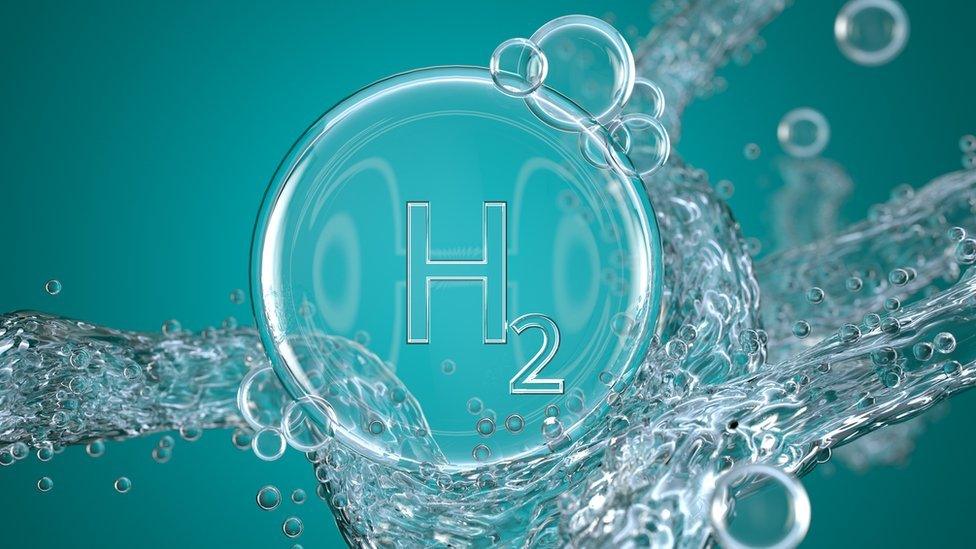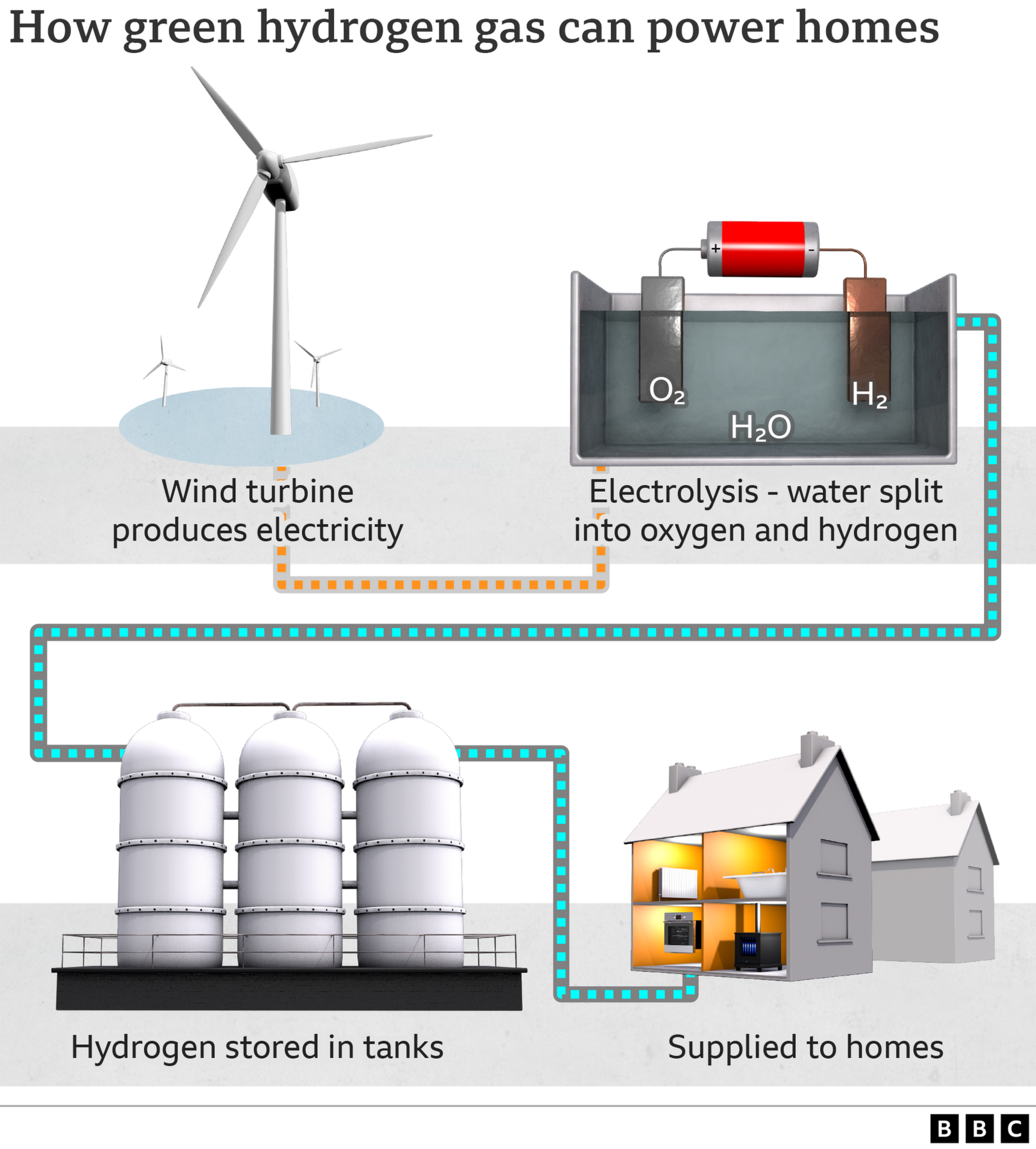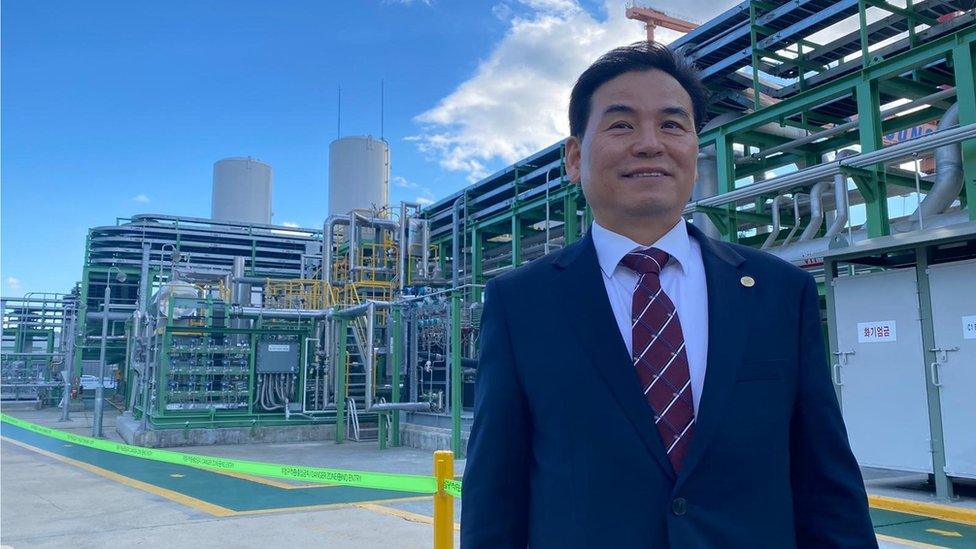Why the Ukraine war may power Asia's green energy shift
- Published

For years there have been calls for Asia - which is home to some of the world's biggest CO2 emitters - to ditch fossil fuels to help tackle climate change.
Countries in the region - including its three biggest economies China, Japan and India - were criticised last year for not making a bigger commitment at the COP26 global climate change conference.
But six months on, there is another, arguably more immediate reason for Asia to make the transition away from oil, gas and coal: money.
Global energy prices have jumped since late February when Russia launched its invasion of Ukraine.
It has pushed European countries to find ways to rely less on Russian gas with Germany hoping hydrogen could be its answer.
Japan and South Korea had also invested heavily in hydrogen technology before the Ukraine war and the soaring cost of energy has provided an additional incentive to accelerate their transition to greener fuels.
However, Asian economies have continued to burn coal to produce electricity despite how much it pollutes the environment.
While some countries have made progress in moving away from fossil fuels, in emergencies - like when two of the region's economic giants China and India were hit by power shortages - it was coal that they turned to.
Japan had invested in nuclear power for decades but after the 2011 Fukushima nuclear accident, it too went back to fossil fuels.
Some experts believe hydrogen can help countries make the transition from fossil fuels to renewables and that is what a growing number of South Korean businesses are now betting on.
The country has so far announced the largest government spending in Asia on the development of hydrogen technology.
Seoul is pushing investments into the production of hydrogen as well as technology for fuel cell power generation and hydrogen-powered cars.
Watch: What is hydrogen energy and why is it important?
Hydrogen is also considered by some experts to be the most practical alternative to fossil fuels as it can be stored as a solid, liquid or gas.
That means, in comparison to solar and wind, it can be more easily stockpiled and transported.
"Hydrogen is like an energy carrier," says Vince Heo of S&P Global Commodity Insights in Seoul.
"You can store energy in the hydrogen and you can use them whenever you want."
A key issue is that there are different types of hydrogen and what South Korea is currently investing in is not emission-free.
The transition to 'green hydrogen'
The goal is to eventually transition to so-called "green hydrogen", which is also known as "clean hydrogen".
It is produced using renewable energy sources, such as wind or solar power, but it is the most expensive type of hydrogen to produce.
That is why hydrogen produced using fossil fuels has been seen by some experts as the first step towards green hydrogen.

"South Korea's hydrogen is currently produced from natural gas," Martin Tengler who is BloombergNEF's lead hydrogen analyst says, explaining that it is referred to as "grey hydrogen".
The next stage in the transition is "blue hydrogen", which is also made using fossil fuels but 60% to 90% of the carbon dioxide produced in the process is captured and stored.
South Korea's biggest natural gas supplier, SK, has invested 18 trillion won, or around ($15bn; £12bn), but only in grey and blue hydrogen.
The boss of its hydrogen business unit, Hyeong-wook Choo, told the BBC the company did not invest in green hydrogen straight away because more technology and investment was needed to do so.
With renewable sources of energy and infrastructure to capture and distribute it not readily available in much of Asia, a major challenge has been to develop the right mix of technologies to harness enough energy to mass produce hydrogen.
"We can develop the market by manufacturing, distributing and consuming hydrogen. So when green hydrogen becomes available, there will be more ability to expand this hydrogen business," Mr Choo added.

Hyeong-wook Choo, the chief executive of SK hydrogen
The crucial issue behind this is how much it costs to produce each of the different types of gas.
"Green hydrogen costs more than two to three times of grey hydrogen," says Mr Heo of S&P Global.
"Currently, it's about $10 per kilogramme to produce green hydrogen."
Mr Heo says to be cost effective, the amount has to decline by 70% to around $3 per kilogramme without government subsidies.
But the jump in global energy prices means that "there's clearly some momentum on green hydrogen because it is produced from renewable energy which is detached from the high fuel prices environment," he added.
For example in Europe, the costs of producing blue and grey hydrogen at times increased by more than 70%, external following the Russian invasion of Ukraine, according to the consultancy Rystad Energy.
If affordable green hydrogen becomes available, there are a number of industries that can benefit.
"We can replace grey hydrogen in industries where there are no emissions-low alternatives like refining petroleum, producing fertiliser and heavy industries like steel production which require high temperatures," Mr Tengler said.
To be able to compete globally, South Korea has created a hydrogen alliance which more than a dozen companies have joined.
"The hydrogen industry at the moment is like the solar industry about 20 years ago where there are few projects being developed and there is a big ambition in the market," said Mr Heo.

South Korea's top maritime university is building an offshore wind platform to produce green hydrogen
Wind power is one of the keys to South Korea's green hydrogen ambitions.
A consortium led by Korea Maritime and Ocean University is developing a floating offshore plant to produce green hydrogen in the city of Busan.
"What we're envisioning is to use electricity from wind and solar out at sea, to boil and electrolyse seawater to produce green hydrogen," Doh Deog-hee, President of Korea Maritime and Ocean University said.
Its advantage is its proximity to hydrogen consumers, Mr Heo said: "You can save the hydrogen transportation costs because that's a big, very expensive part of the hydrogen value chain."
"But floating offshore wind costs more than $300 per megawatt hour compared to $100 per megawatt hour of using solar power so how to actually optimise the cost of producing hydrogen from this facility is a big question," he added.
The transition to cleaner sources of energy has always been costly.
When global leaders met for COP26 in November, the world was starting to face higher fuel prices due to the pent-up demand after the pandemic lockdowns.
For many countries it was, and still is, very tempting to go back to fossil fuels.
The question is whether the soaring fuel prices could be a bigger motivator for a change.
- Published24 May 2022

- Published22 August 2022

- Published23 May 2022

- Published23 May 2022
